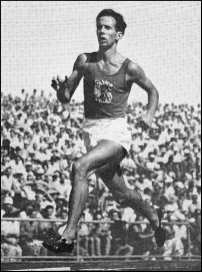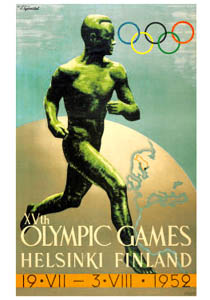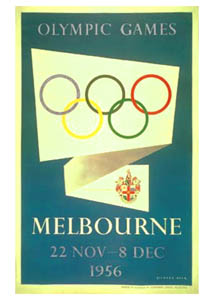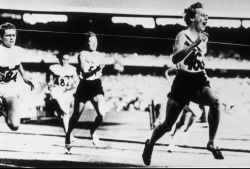Running in the 50's
From fifties
Contents |
[edit] Running Equipment
[edit] Shoes
Running competition shoes, called spikes, have six widely placed spikes on the bottom of the forefoot to provide traction during races. The cross-country spike is made with a rubber heel, and the upper is generally made from yellow kangaroo leather. The track spike has a rubber pad on the inside of the heel, and the spike placement is closer to the center of the forefoot. The spikes are changeable and different lengths of spikes are used for different course conditions. A longer spike is used for softer, muddier ground; and short spikes are used for drier, firmer ground. Rubber flats are used for warming up; and for running races on mostly cement or frozen ground, when spikes cannot be used.
[edit] Clothing
[edit] Socks
Socks should be cotton and lightweight. White socks are prefered, since the dye could get into an open blister when the foot perspires and cause an infection. Wax or soap may be rubbed on the inside of the sock to deter blistering.
[edit] Uniform
Fit rather than appearance is important when considering track shorts. They should allow freedom of movement and unrestricted breathing.
Jerseys are usually made from lightweight cotton or rayon. Most jerseys are sleeveless, but some runners prefer a T-shirt.
[edit] The Track
The Track is 400 meters long for international Tracks, and 440 yards for Tracks in the United States. Tile is laid down first, then a rough fill of gravel, middle layer of coarse cinder, and a top dressing of a mixture of clay and cinder. The Track is easily torn up from Spikes and must be regularly maintained.
[edit] The 4 Minute Mile
In the fifties "most people considered running four laps of the track in four minutes to be beyond the limits of human speed... Some thought that rather than a lifetime of glory, honor, and fortune, a hearse would be waiting for the first person to accomplish the feat. (Bascomb, pg. ix)" From 1952 to 1954 two men set out to do just that: break the four minute mile. These two men were Roger Bannister from England, and John Landy from Australia.
Roger Bannister was a medical student working at St. Mary's Hospital. After finishing a disappointing fourth place at the 1952 Olympics, Bannister enlisted his friends Chris Chataway and Chris Brasher to help him in his quest for the four minute mile.
John Landy, an aspiring entomologist studying agriculture science at Melbourne University, did most of his training alone. He had been under then tutelage of Percy Cerutty, but decided to leave the coach to put together his own schedules and workouts.
On December 13th 1952, Landy ran a 4:02.1 for the mile at Olympic Park in Melbourne, a huge personal record, an Australian Record and the 3rd fastest mile in history. This previously unheard of runner was suddenly being written about in newspapers around the world. Bannister heard the news and stepped up his training because of it. Both runners had demanding shedules because of their studies, and often did most of their training on lunch breaks and at night. Landy doing speed work and intervals mixed with long miles, Bannister running fartleks at cricket fields.
The runners inched closer and closer to the four minute barrier: January 22nd 1953, at the Australian Championships in Perth Landy clocked a 4:04.2 May 2nd 1953, Bannister ran a 4:03.6. Good enough for a new British Record and the 5th fastest mile time in history. June 27th 1953, with pacing help from Australian Don Macmillan and Chris Brasher, Bannister ran 4:02. Bannister was then convinced by Chris Chataway and Chris Brasher to begin training under their coach, Austrian Franz Stampfl. January 21st 1954, Landy ran a 4:02.4. Soon after this he decided to go to Finnland, where he would be able to compete against the best in the world, and hopefully give him a better shot at the world record.
After months of training with Chataway and Brasher, Bannister and Stampfl agreed that they would try to break four minutes at the Amateur Athletic Association vs. Oxford meet on May 6th. The plan was to have Brasher set the pace for 2 1/2 laps, Chataway take over until 3 1/2 laps, and then the last half lap was up to Bannister.
On the morning of May 6th 1954, Bannister looked out his window to windy, grey skies. Throughout the day Bannister kept looking out the windows of St. Mary's while doing his work for the day, hoping the weather would improve. At the track, Bannister, Brasher, and Chataway decided they would wait to see if they would call off their attempt, depending on what the weather would do.
45 minutes until race time, they headed out for their warm up when it started to rain, this did not look good. If it rained too much, the track would be left in less than desirable condition. 15 minutes until race time a rainbow appeared, but the wind did not slacken. Bannister headed out to do some final strides before he would have to toe the line, when he looked across the street to where the flag of England was flying on top of a church steeple. He saw the flag go slack, and he decided to go for the record. When the gun went off, Brasher took the lead. They ran the first lap in 57.5. At the half mile, Brasher still lead them through with a 1:58. Chataway took over on the back stretch, and led Bannister at the bell with a time of 3:00.8. Bannister took the lead with a half lap to go. He passed the 1500 meter mark with a time of 3:43, world record pace. Bannister gave everything he had, and crossed the finish line with a time of 3:59.4.
John Landy heard what Bannister had done, but did not give up, and decided that he would still try to run a sub 4 minute mile. On May 31st 1954, in Turku Finland, Landy gave a gallant effort, but ran a 4:01.6. A new personal record, but still not under 4. Chris Chataway received an invitation to come to Turku to run agains Landy in the 1500 m. Chataway asked that if they changed the race to a mile, he would come. The distance was changed, and Chataway set off for Finland to run against Landy. On June 21st 1954, Landy and Chataway toed the line. The first lap was run in 58.5 seconds, at the half mile 1:57.9, at the bell Landy ran a 2:56 with Chataway right behind. Landy had never had someone stay with him for this long in a race before.
Finally Landy began to pull away from Chataway. At 1500m the time was 3:41.8. Landy was up on his toes, driving towards the finish line. He crossed the tape in a time of 3:58. A new world record, and the second man to go under 4 minutes, just 46 days after the 4 minute barrier had been broken. There was only one thing for these milers to do: run against each other in a head to head competition. This would be at the Empire Games in Vancouver, British Columbia. This race was dubbed "The Mile of the Century". A few nights before the race, Landy could not get to sleep, so he decided to go for a relaxing run. Running around in the grass, barefoot, he suddenly felt a sharp pain in his foot. He had stepped on a photographer's flash bulb, which left a huge gash in his foot.
Landy and his friends decided that he should go see a doctor, so they arranged for a car to take them to the University of British Columbia health center. The doctor was sworn to secrecy, because Landy did not want this leaked out to the press; he wanted no excuses. Landy would not let the doctor stitch his foot, and instead had him tightly tape it so that he could run on it. On August 7th 1954 at 2:30 pm, Landy and Bannister stepped on the line together. The gun went off. For the first half lap the runners jockeyed for position. Landy then took the lead. The first lap was a 58.2 for Landy, with Bannister six tenths of a second behind. Landy lengthened his gap. At the half mile, Landy ran a 1:58.2, and Bannister a 1:59.4. Bannister began to slowly move up on Landy. At the three quarter mile mark Landy posted a 2:58.4, with Bannister tree tenths of a second behind. As the two runners entered the home stretch, Landy looked over his left shoulder, at that precise moment Bannister passed on the right to gain the lead.
Both runners sprinted to the finish line. Bannister finishing in 3:58.8, Landy in 3:59.6. At the awards stand "Bannister looked out across the stadium, overwhelmed by the sight of it all. It was his finest moment. He had beaten the nest of competitors in John Landy. He had brought glory to his country. He had captured victory in a race greater than any numerical barrier. Roger Bannister had run the perfect mile. (Bascomb, pg. 255)"
[edit] The Human Locomotive
At the 1952 Olympics in Helsinki, Finland, history was made. In the 10,000 meter race, Emil Zatopek, from Czechoslovakia, wore out his opponents one by one. He was alone in the lead with four laps to go of the 25 lap race. He finished in an Olympic record of 29:17.0, fifteen seconds ahead of second place. Zatopek had planned on running the Marathon also. After he won the 10K, he was asked if it was true that he would also compete in the 5,000 meters. He said: "The marathon contest won't be for a long time yet, so I simply must do something until then." Zatopek ran an easy heat to qualify for the final. In the final of the 12 1/2 lap race, the lead changed many times. In the backstretch of the last lap Chris Chataway took the lead, with Zatopek in fourth behind Alain Mimoun of France, and Herbert Schade of Germany. Entering the last curve Zatopek moved into the lead with Chataway close behind, then, on the homestretch Chataway tripped on the curb and fell. Zatopek won his second gold metal of the '52 Olympics with an Olympic Record of 14:06.6. Zatopek still had the Marathon to run, a distance he had never raced before. At 15K into the race, Zatopek caught up with the race leader, Jim Peters of Great Britain. A few miles later he passed Peters, but closely followed by Gustav Jansson of Sweden. By 20 miles Zatopek shook off Jansson, and led the race alone. When he entered the stadium, a huge crowd greeted him, cheering: "Za-to-pek! Za-to-pek!" Zatopek had earned his third gold metal and third Olympic Record with a time of 2 hours, 23 minutes, and 3.2 seconds.
Zatopek earned the nickname 'The Human Locomotive' because "Whenever he ran, his face was always contorted by a grimace, and his shoulders and body looked hunched with pain" (Wallechinsky, pg.77)" When asked about his unusuall running style, Zatopek responded: "I was not talented enough to run and smile at the same time."
[edit] The Olympics
[edit] Men's Results
[edit] 1952 Helsinki, Finland
Distace, Name, Country, Time
- 100m, Lindy Remigo ,USA, 10.4
- 200m, Andrew Stanfield, USA, 20.7 OR
- 400m, V. George Rhoden, JAM, 45.9 OR
- 800m, Malvin Whitfield, USA, 1:49.2 OR
- 1500m, Josef 'Josy' Barthel, LUX, 3:45.1 OR
- 5000m, Emil Zatopek, CZE, 14:06.6 OR
- 10000m, Emil Zatopek, CZE, 29:17.0 OR
- Marathon, Emil Zatopek, CZE, 2:23:03.2 OR
- 110m Hurdles, Harrison Dillard, USA, 13.7 OR
- 400m Hurdles, Charles Moore, USA, 50.8 OR
- 3K Steeplechase, Horace Ashenfelter, USA, 8:45.4 WR
- 4x100m relay, (Smith, Dillard, Remigino, Stanfield), USA, 40.1
- 4x400m relay, (Wint, Laing, McKenley, Rhoden), JAM, 3:03.9 WR
[edit] 1956 Melbourne, Australia
Distance, Name, Country, Time
- 100m, Bobby Joe Morrow, USA, 10.5
- 200m, Bobby Joew Morrow, USA, 20.6 OR
- 400m, Charles Jenkins, USA, 46.7
- 800m, Thomas Courtney, USA, 1:47.7 OR
- 1500m, Ron Delany, IRL, 3:41.2 OR
- 5000m, Volodymyr Kuts, SOV\UKR, 13:39.6 OR
- 10000m Volodymyr Kuts, SOV\UKR, 28:45.6 OR
- Marathon, Alain Mimoun, FRA, 2:25:00
- 110m Hurdles, Lee Calhoun, USA, 13.5 OR
- 400m Hurdles, Glenn Davis, USA 50.1 )R
- 3K Steeplechase, Christopher Brasher, GBR, 8:41.2 OR
- 4x100m relay, (Murchison, King, Baker, Morrow), USA, 39.5 WR
- 4x400m relay, (Jones, Mashburn, Jenkins, Courtney), USA, 3:04.8
[edit] Women's Results
[edit] 1952 Helsinki, Finland
Distance, Name, Country, Time
- 100m, Marjorie Jackson, AUS, 11.5 WR
- 200m, Marjorie Jackson, AUS, 23.7
- 80m Hurdles, Shirley Strickland de la Hunty, AUS, 10.9 WR
- 4x100m relay (Faggs, Jones, Moreau, Hardy), USA, 45.9 WR
[edit] 1956 Melbourne, Australia
Distance, Name, Country, Time
- 100m, Elizabeth Cuthbert, AUS, 11.5
- 200m, Elizabeth Cuthbert, AUS, 23.4 OR
- 80m Hurdles, Shirley Strickland de la Hunty, AUS, 10.7 OR
- 4x100 relay, (Hunty, Croker, Mellor, Cuthbert), AUS, 44.5 WR
[edit] Bibliography
- Bascomb, Neal. The Perfect Mile.
Houghton Mifflin Books. 2004.
- Wallechinsky, David. The Complete Book of the Summer Olympics.
Litte, Brown & Company. 1996.
- Doherty, J. Kenneth. Modern Track and Field.
Prentice-Hall. 1953.
- Cooper, John. Mortensen, Jesse. Track and Field for Coach and Athlete.
Prentice-Hall.1959.
- Kinzle, Donn. Practical Track Athletics.
The Ronald Press Company. 1957.
- Chatam, Don. Micoleau, Tyler. Track Techniques Illustrated.
The Ronald Press Company. 1952.














